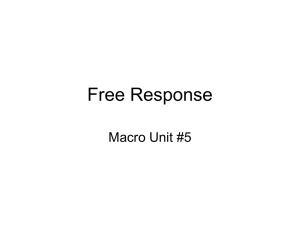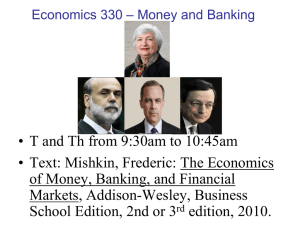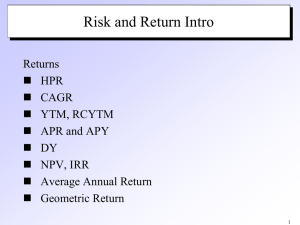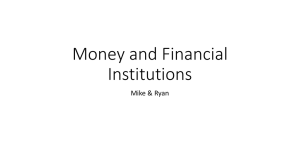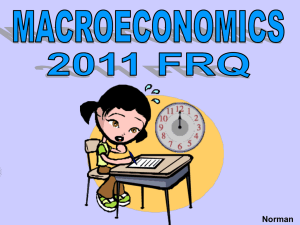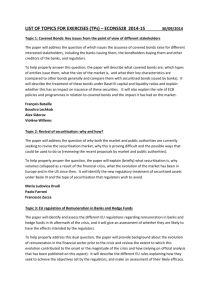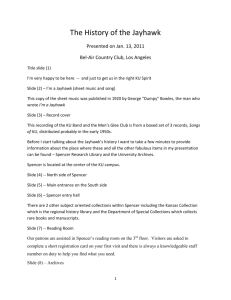Midterm 2
advertisement
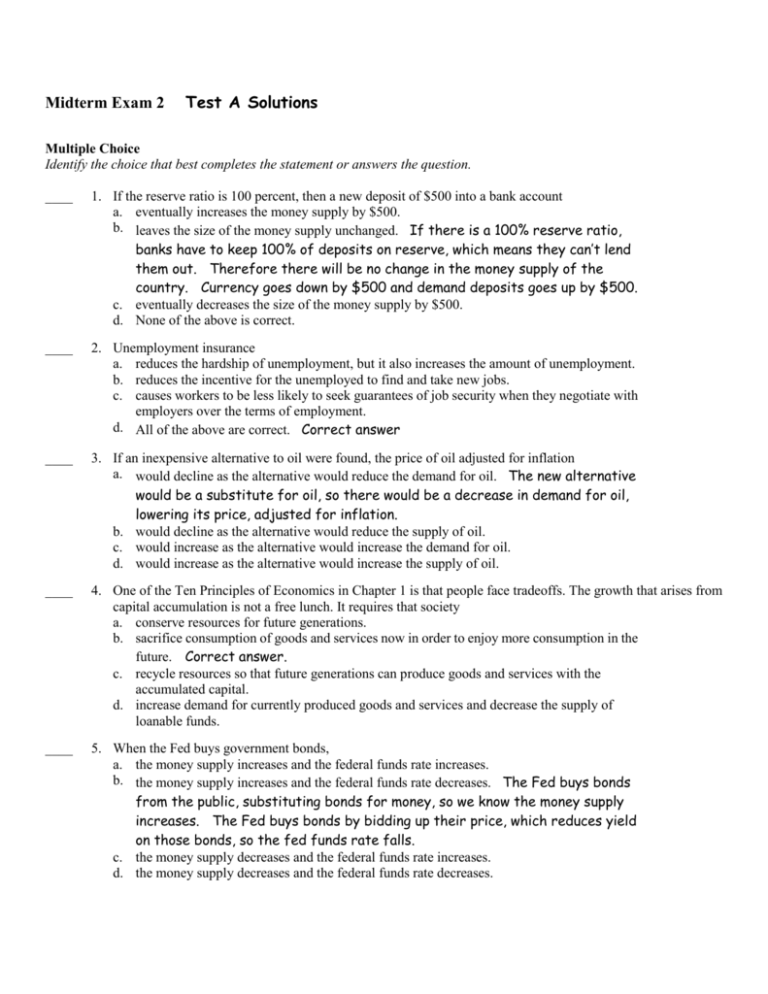
Midterm Exam 2 Test A Solutions Multiple Choice Identify the choice that best completes the statement or answers the question. ____ 1. If the reserve ratio is 100 percent, then a new deposit of $500 into a bank account a. eventually increases the money supply by $500. b. leaves the size of the money supply unchanged. If there is a 100% reserve ratio, banks have to keep 100% of deposits on reserve, which means they can’t lend them out. Therefore there will be no change in the money supply of the country. Currency goes down by $500 and demand deposits goes up by $500. c. eventually decreases the size of the money supply by $500. d. None of the above is correct. ____ 2. Unemployment insurance a. reduces the hardship of unemployment, but it also increases the amount of unemployment. b. reduces the incentive for the unemployed to find and take new jobs. c. causes workers to be less likely to seek guarantees of job security when they negotiate with employers over the terms of employment. d. All of the above are correct. Correct answer ____ 3. If an inexpensive alternative to oil were found, the price of oil adjusted for inflation a. would decline as the alternative would reduce the demand for oil. The new alternative would be a substitute for oil, so there would be a decrease in demand for oil, lowering its price, adjusted for inflation. b. would decline as the alternative would reduce the supply of oil. c. would increase as the alternative would increase the demand for oil. d. would increase as the alternative would increase the supply of oil. ____ 4. One of the Ten Principles of Economics in Chapter 1 is that people face tradeoffs. The growth that arises from capital accumulation is not a free lunch. It requires that society a. conserve resources for future generations. b. sacrifice consumption of goods and services now in order to enjoy more consumption in the future. Correct answer. c. recycle resources so that future generations can produce goods and services with the accumulated capital. d. increase demand for currently produced goods and services and decrease the supply of loanable funds. ____ 5. When the Fed buys government bonds, a. the money supply increases and the federal funds rate increases. b. the money supply increases and the federal funds rate decreases. The Fed buys bonds from the public, substituting bonds for money, so we know the money supply increases. The Fed buys bonds by bidding up their price, which reduces yield on those bonds, so the fed funds rate falls. c. the money supply decreases and the federal funds rate increases. d. the money supply decreases and the federal funds rate decreases. ____ 6. Which of the following statements is true? a. Productivity is calculated as hours worked divided by output produced. No, it’s total output divided by hours. b. Americans have a higher standard of living than Indonesians because American workers are more productive than Indonesian workers. True. c. Trends in the market prices of most resources indicate that they have become increasingly scarce over time. Just the opposite is true. d. All of the above are correct. ____ 7. Social Security a. is a fund that you put money into, the government invests it for you, and gives you the money plus interest and dividends when you retire. b. is funded by general government revenue sources such as the income tax. c. will go bankrupt in about 40 years which means that people who retire in about 2050 will get no Social Security benefits. d. is funded by taxes paid equally by employees and employers, but economic analysis says that the ultimate incidence of the tax is on the employee. a. is a fund that you put money into, the c. will go bankrupt in about 40 years which government invests it for you, and gives means that people who retire in about 2050 you the money plus interest and dividends will get no Social Security benefits.It will when you retire. Not how it works not go bankrupt. There will not be enough revenues to support promised payments, though. b. funded by general government revenue d. is funded by taxes paid equally by employees and employers, but economic sources such as the income tax. No, it is analysis says that the ultimate incidence of funded by a dedicated tax. the tax is on the employee. True ____ 8. Other things the same, which bond would you expect to pay the highest interest rate? a. a bond issued by the U.S. government b. a bond issued by IBM c. a bond issued by New York State d. a bond issued by a new restaurant chain This is the riskiest borrower, so it pays the highest interest rate. The lowest rate would be paid by the U.S. government, then NY State, then IBM. ____ 9. You observe an economy that has no exports or imports, a government deficit, and positive investment. Which of the following is correct? If there is a government deficit, then public saving is negative. Since there is positive investment, the funds must come from somewhere, and they don’t come from abroad, so there must be private savings, so b. a. Private and public saving are both positive. b. Private saving is positive; public saving is negative. c. Private saving is negative; public saving is positive. d. Both private saving and public saving are negative. ____ 10. Which of the following statements about personal financial decisions is true? a. By hiring an investment manager who has c. By diversifying your portfolio of stocks a proven track record in picking stocks to and bonds, you will reduce the riskiness of pick stocks for you, it is much more likely your investments. True that you will get a higher return on your investments than by investing in a stock index fund. No, index funds do better than most investment managers. b. in a typical ten year period, a professional d. In general, investing in bonds is riskier who picks stocks will beat the average than investing in stocks. No. Stocks return to all stocks in the stock market. No, are riskier than bonds. just the opposite. ____ 11. Consider a small economy in which consumers buy only two goods: apples and pears. In order to compute the consumer price index for this economy for two or more consecutive years, we assume that a. the number of apples bought by the typical consumer is equal to the number of pears bought by the typical consumer in each year. Yes, in the language we have used, the number of each good put into the market basket stays the same each year. The only thing that changes is the price of the goods in the basket. b. neither the number of apples nor the number of pears bought by the typical consumer changes from year to year. c. the percentage change in the price of apples is equal to the percentage change in the price of pears from year to year. d. neither the price of apples nor the price of pears changes from year to year. ____ 12. Fred is considering expanding his dress shop. If interest rates rise he is a. less likely to expand. This illustrates why the supply of loanable funds slopes downward. b. more likely to expand. This illustrates why the supply of loanable funds slopes upward. c. less likely to expand. This illustrates why the demand for loanable funds slopes downward. d. more likely to expand. This illustrates why the demand for loanable funds slopes upward. Fred is a demander of loanable funds. With higher interest rates, he is less likely to expand (he moves up his demand curve.) ____ 13. The Peapod Restaurant uses all of the following to produce vegetarian meals. Which of them is an example of physical capital? a. the owner's knowledge of how to prepare vegetarian entrees Human capital b. the money in the owner's account at the bank from which she borrowed money Financial capital c. the tables and chairs in the restaurant This is physical capital for the restaurant. d. the land the restaurant was built on Natural resource ____ 14. The state of Vermont recently received bids from private sellers to sell more solar powered electricity to the state than it was prepared to buy. a. This is an example of demand exceeding c. The state’s policy incurred no cost to supply. anyone so this policy was designed well. b. The state could have bought the amount of d. Solar electricity is cheaper than other, solar-generated electricity it requested at a conventional sources, so the state should cheaper price if it had used basic economic purchase all the solar powered electricity that was offered to it rather than limiting reasoning. As discussed in class, this the quantity supplied. is correct. ____ 15. The theory of efficiency wages provides a possible explanation as to why a. workers form unions. b. firms should try to reduce surpluses of labor. c. firms may be inclined to keep their workers’ wages above the equilibrium level. Correct d. firms may be inclined to keep their workers’ wages below the equilibrium level. ____ 16. John is a stockbroker. He has had several job offers, but he has turned them down because he thinks he can find a firm that better matches his tastes and skills. Curtis has looked for work as an accountant for some time. While the demand for accountants doesn’t appear to be falling, there seems to be more people applying than jobs available. a. John and Curtis are both frictionally unemployed. b. John and Curtis are both structurally unemployed. c. John is frictionally unemployed, and Curtis is structurally unemployed. Correct d. John is structurally unemployed, and Curtis is frictionally unemployed. ____ 17. When the Fed conducts open market purchases, reserves a. increase and banks can increase lending. The Fed purchases securities, which gives people more cash, which they deposit in banks, which get lent out. b. increase and banks must decrease lending. c. decrease and banks can increase lending. d. decrease and banks must decrease lending. ____ 18. Dollar bills, rare paintings, and emerald necklaces are all a. media of exchange. b. units of account. c. stores of value. All are stores of value, but only dollar bills are media of exchange and units of account. d. All of the above are correct. ____ 19. A bank’s liabilities include a. both its reserves and the deposits of its customers. b. neither its reserves nor the deposits of its customers. c. its reserves, but not the deposits of its customers. d. the deposits of its customers, but not its reserves. Correct ____ 20. According to current data on the U.S. population, which of the following groups of people has the highest unemployment rate? a. white males b. white females c. black males Correct d. college educated males 21. Which of the following is true about the financial crisis that has affected the nation for the past 18 months: a. the decline in housing values has reduced c. banks and financial institutions that are deemed “too big to fail” have behaved banks’ liabilities. No. it has reduced more carefully than other banks because the value of banks’ assets. they acknowledge a special social and economic responsibility. No, just the opposite. b. credit default swaps, an insurance policy to d. banks have had to try to increase their protect buyers of mortgage backed capital to offset the decline in the value of securities, were not used by many of the their assets. Yes, this is true. financial institutions that had problems during the financial crisis. This type of insurance policy WAS used by financial institutions. ____ 22. A U.S. Treasury bond is a a. store of value and common medium of exchange. b. store of value, but not a common medium of exchange. Correct. c. a common medium of exchange, but not a store of value. d. neither a store of value nor a common medium of exchange. ____ 23. Despite its status as one of the richest countries in the world, Japan a. has a very low level of productivity. b. has few natural resources. Correct. It has high productivity, high human capital, and engages in lots of trade. c. has very little human capital. d. engages in a relatively small amount of international trade. ____ 24. If the CPI was 110 this year and 100 last year, then a. the cost of the CPI basket of goods and services increased by 110 percent this year. NO, it increased by 10%. b. the price level increased by 10 percent this year. This is the only answer that is true. c. the inflation rate for this year was 10 percent higher than the inflation rate for last year. No, the inflation rate was 10%. We don’t know what it was last year. d. All of the above are correct. ____ 25. Suppose a bank has a 10 percent reserve requirement, $5,000 in deposits, and has loaned out all it can given the reserve requirement. With 10% reserve requirements and $5,000 in deposits, it must have $500 in reserves. Since assets = liabilities and liabilities are $5,000, total assets are $5,000 which means the bank must have $4,500 in loans outstanding, so b. a. It has $50 in reserves and $4,950 in loans. b. It has $500 in reserves and $4,500 in loans. c. It has $555 in reserves and $4,445 in loans. d. None of the above is correct. ____ 26. An increase in the minimum wage would a. increase both the quantity demanded and the quantity supplied of labor. b. decrease both the quantity demanded and the quantity supplied of labor. c. increase the quantity of labor demanded but decrease the quantity of labor supplied. d. decrease the quantity of labor demanded but increase the quantity of labor supplied. Draw a supply and demand (for labor) graph and have the minimum wage above the equilibrium. ____ 27. When saving for a goal that is twenty years in the future. a. corporate bonds have a low risk and a high return. b. investing in a stock mutual fund will have the highest return and the long time period will offset the higher risk you incur by investing in stocks. c. picking one stock that is sure to rise over that period of time is the safest investment. d. picking one stock that is sure to rise over that period of time is the safest investment. a. government bonds are probably the best c. picking one stock that is sure to rise over investment because they have a low risk that period of time is the safest investment. and a high return. Low risk, but also low You can’t be sure that any stock will return. rise over that period of time. b. investing in a stock mutual fund will have d. choosing a financial advisor to pick one or the highest return and the long time period a few stocks is the most important will offset the higher risk you incur by decision you can make.No, especially if investing in stocks. Yes you are using the advisor to pick only one or a few stocks. ____ 28. The earned income tax credit a. is another name for the minimum wage b. is a part of the income tax system that rewards firms for hiring low skilled workers. It does not reward firms. c. is a program to give low income workers a supplement to their salary through the tax system. This is exactly what it is. d. is used by banks to make more loans to people who earn a low income, and is also called a subprime loan. No ____ 29. A national chain of grocery stores wants to finance the construction of several new stores. The firm has limited internal funds, so it likely will a. demand the required funds by buying bonds. b. demand the required funds by selling bonds. It is a demander of funds, and it does this by selling bonds and getting money in return. c. supply the required funds by buying bonds. d. supply the required funds by selling bonds. ____ 30. Ralph puts money in the bank and earns a 5 percent nominal interest rate. If the inflation rate is 2 percent, then after one year, a. Ralph will have 3 percent more money, which will purchase 5 percent more goods. b. Ralph will have 3 percent more money, which will purchase 7 percent more goods. c. Ralph will have 5 percent more money, which will purchase 3 percent more goods.Yes d. Ralph will have 5 percent more money, which will purchase 7 percent more goods. ____ 31. The ratio of debt to GDP in the United States tended to fall a. during wars. b. during the late 1990s. It fell during the economic boom of the 1990s when the government ran budget surpluses. c. during the first half of this decade d. None of the above is correct. ____ 32. The bet that economist Julian Simon had with biologist Paul Ehrlich in 1980 a. essentially showed that human capital was c. essentially showed that natural resources more important to economic growth than were becoming relatively more abundant natural resources during the decade of the and cheaper during the decade of the 1980s. 1980s. Yes. All the resources fell in price. b. essentially showed that the earth’s d. essentially showed that natural resources temperature was rising over the decade of were becoming relatively more scarce and the 1980s. expensive during the decade of the 1980s. ____ 33. Economists use the term inflation to describe a situation in which a. some prices are rising faster than others. b. the economy's overall price level is rising. Yes c. the economy's overall price level is high, but not necessarily rising. d. the economy's overall output of goods and services is rising faster than the economy's overall price level. ____ 34. In which of the following sets of assets are the assets correctly ranked from most liquid to least liquid? a. money, bonds, cars, houses Money is the most liquid, then bonds. b. money, cars, houses, bonds c. bonds, money, cars, houses d. bonds, cars, money, houses ____ 35. Larry buys stock in A to Z Express Company. Curly Corporation builds a new factory. Which transaction would be an act of investment in the language of macroeconomics? a. Only Larry’s. c. Both Larry’s and Curly Corporation’s. b. Only Curly Corporation’s. Investment is d. Neither Larry’s nor Curly Corporation’s. the physical construction of something like a factory, not the purchase of pieces of paper (financial assets). ____ 36. Over the past 12 months the consumer price index a. has increased by about 1% c. was re-indexed so we cannot make any inferences about inflation. b. has decreased by about 1% Yes d. has increased at a rate that economists consider to be highly inflationary. ____ 37. Suppose banks desire to hold no excess reserves and that the Fed has set a reserve requirement of 10 percent. If you deposit $9,000 into First Jayhawk Bank, a. First Jayhawk’s required reserves increase by $900. Yes, the bank must keep $900 of the $9000 as required reserves. b. First Jayhawk will be able to lend out $8,100. Therefore it can lend out $8,100 c. First Jayhawk’s assets and liabilities both will increase by $9,000. And when it does this, both sides of the balance sheet rise by $9,000. d. All of the above are correct. So this is correct. ____ 38. Investment from abroad a. is a way for poor countries to learn the state-of-the-art technologies developed and used in richer countries. b. is viewed by economists as a way to increase growth. c. often requires removing restrictions that governments have imposed on foreign ownership of domestic capital. d. All of the above are correct. Yes. ____ 39. A problem that the Fed faces when it attempts to control the money supply is that a. since the U.S. has a fractional-reserve banking system, the amount of money in the economy depends in part on the behavior of depositors and bankers. Yes b. the Fed has to get the approval of the U.S. Treasury Department whenever it uses any of its monetary policy tools. No, the Fed is independent of the Treasury c. while the Fed has the ability to change the money supply by a large amount, it does not have the ability to change it by a small amount. No. d. federal legislation in the 1950s stripped the Fed of its power to act as a lender of last resort to banks. No. ____ 40. A larger federal government budget deficit a. raises the interest rate and investment. b. reduces the interest rate and investment. c. raises the interest rate and reduces investment. Yes. d. reduces the interest rate and raises investment. Grades: A B C D F 34-40 30-33 25-29 20-24 <19


